The Zen of Astrophysics
Speaking in broad generalities, there are two main classes of physicist: those who generate new hypotheses and those who generate new data. The former are called "theorists" and the latter, in most of physics, are called "experimentalists." In astrophysics, we're called "observers" because we can't do experiments in the traditional sense. We have no knobs to turn, no switches to flip; we can't turn the dial to a maximally spinning black hole just to see what happens (oh, what fun that would be!). Instead, we look at what's already there and try to figure out what it is we're looking at. In a nutshell, that's our job; we try to make to make sense of the small parts of the universe that interest us, but in a very hands-off way.
So, there's a Zen to astrophysics --- we must accept what nature gives us, what nature shows us when we look. Wanting something different or wishing we could change what's there will only lead to frustration, desperation, and poor personal hygiene. Much like Popeye, the universe is what it is, and that's all that it is. We just need to sit back and enjoy the view.
To make sense of it all, we need to be clever about what to look at and how to look at it. What I mean is: we have some powerful, but limited, resources available in X-ray astrophysics, and there are way more questions to be answered than there is time available to answer them. It may be going a bit far to call it an "art," but there is definitely a creative aspect to designing an observation or a series of observations so that you can squeeze as much science as possible out of those photons that are detected.
One common and powerful strategy is to observe several examples of a certain type of object and synthesize the results. The similarities and the differences among objects of the same class are a powerful clue to the underlying physics. For example, when we observed several globular clusters with Chandra, we saw that some globular clusters had dozens and dozens of X-ray sources and others had very few, maybe only one or two. We were able to figure out the reason for this, namely, that the majority of these X-ray sources are made by the globular clusters themselves through close encounters between stars. So, the more encounters, the more X-ray sources, which is exactly what we saw with Chandra.
What got me starting thinking about all this is that I was thinking about the future of X-ray astronomy, which is a bit uncertain at this point (to put it mildly). I remind myself that whatever the capabilities of the next satellite, we observers will think up novel observational strategies and cool things to do that weren't even considered before the satellite was launched. I'm sure that before Chandra was launched, no one thought it would be used to determine the dark matter content of elliptical galaxies, but that's exactly what my colleagues and I are doing right now with Chandra data.
That's what we do. We figure out the most interesting things we can do with the capabilities we have. That's what makes an observational X-ray astrophysicist an observational X-ray astrophysicist.
-Dave Pooley
---------------
Dave Pooley currently studies the Universe from Madison, Wisconsin. In addition to his five senses, he also uses telescopes like Chandra.

